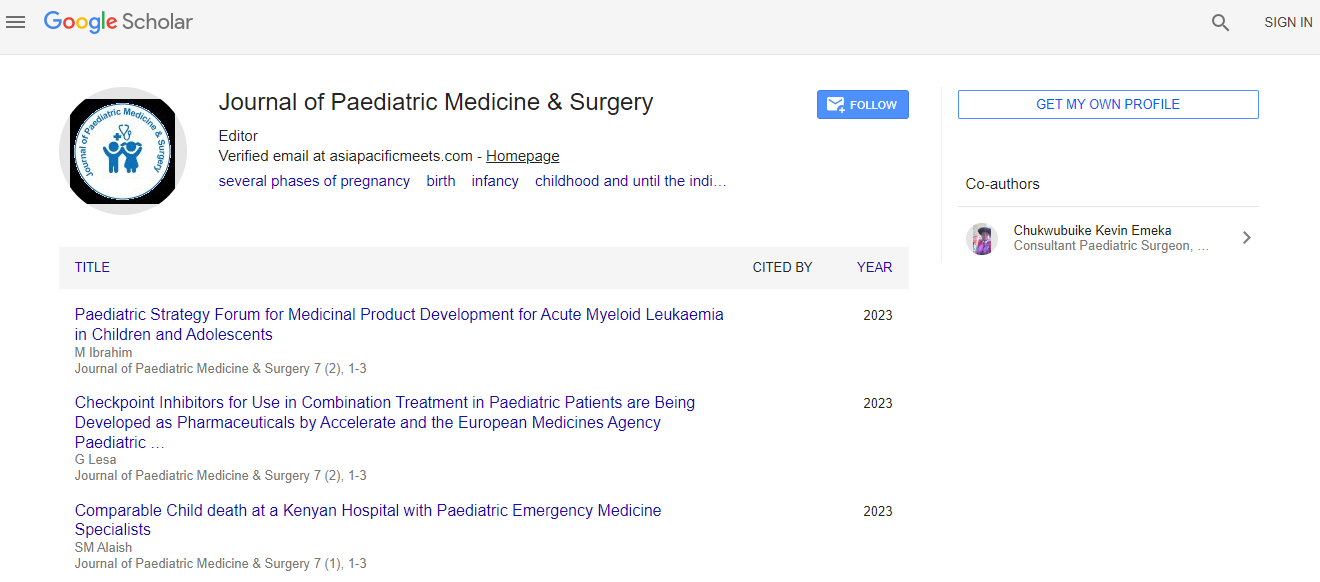Pediatric Surgery & Neonatology 2018: Effects of deformational plagiocephaly during the first 12 months on the psychomotor development of prematurely born infants - Assistance Publique Hôpitaux de Marseille
*Corresponding Author:
Copyright: © 2018 . This is an open-access article distributed under the terms of the Creative Commons Attribution License, which permits unrestricted use, distribution, and reproduction in any medium, provided the original author and source are credited.
Abstract
Aims: The connection between deformational plagiocephaly and psychomotor development is a recurring question in medical publications. Mainly publications focus on term children, but there is a lack of data on the impact of deformational plagiocephaly on the long-term neurodevelopment of premature infants. We tried to found a possible relation between deformational plagiocephaly during the 1st year of life and the psychomotor score at 4 years in prematurely born infants. Other risk factors potentially impacting the psychomotor score were also studied. A total of 120 infants were examined 3 times each. The presence of deformational plagiocephaly and a score of 0-6 on an irregularity performance scale served as outcome measures at 6 months CA. Predictive factors were determined using regression analysis. In a retrospective study, occurrences of idiopathic irregularity and DP, supposed forecasters, and Alberta Infant Motor Scale scores at 6 months CA were inattentive and analysed with Chi(2), Mann-Whitney, logistic regression and T-test.
Material and methods: A retrospective study of the files of the children followed by the "Naître et Devenir Région PACA Ouest Corse Sud" healthcare network and included in the database allowed us to select a cohort of 594 infants born prematurely at under 33 weeks of gestational age. These children were developmentally evaluated during the 1st year of life and at 4 years or age using the "EVAL Mater" test. A total of 120 infants were examined 3 times each. The presence of deformational plagiocephaly and a score of 0-6 on an asymmetry performance scale served as outcome procedures at 6 months CA. Predictive factors were determined using regression analysis. In a reflective study, frequencies of idiopathic asymmetry and DP, putative predictors, and Alberta Infant Motor Scale scores at 6 months CA were abstracted and analyzed with Chi(2), Mann-Whitney, logistic regression and T-test. The "Naître et Devenir" network is following up infants born prematurely at under 33 weeks of gestation in the West Provence Alpes Côte d'Azur and South Corsica region, from discharge to 7 years. A group of 170 specially trained pediatricians follow these infants developmentally at term, 3, 6, 9, 12, 18, and 24 months of corrected age and 3, 4 5, 6, and 7 years. Data are collected in a specially designed database.
Results: There was no significant link between deformational plagiocephaly during the 1st year of life and a pathological psychomotor score at age 4, but some risk factors were demonstrated: male gender, birth at under 28 weeks of gestational age, weight at birth under 1000g, having a Latal and Ferriero neuromotor score equal to or greater than 2 at 3 months of corrected age, and to a lesser extent having a prescription for physiotherapy during the 1st year.
Conclusion: The research on deformational plagiocephaly in the full-term infant suggests a relation between deformational plagiocephaly and developmental delay predominantly on the motor side, with an increased rate of special needs services at school age. The question is raised of whether deformational plagiocephaly is the cause of the delay or an early sign of cerebral anomaly with an early motor delay in full-term infants. Infants born very preterm may develop deformational plagiocephaly. A positional preference of the head at TEA seems to be a normal aspect of these infants' motor repertoire, with limited ability to predict persistence of an asymmetric motor performance. The decreased prevalence of deformational plagiocephaly between 3 and 6 months CA indicates an optimistic course. Children with a past of chronic lung disease and/or leisurely gross motor maturation merit timely intervention. The great prevalence of a positional preference in children born preterm at term equivalent age requires extra alertness to prevent the development of a deformational plagiocephaly, especially in boys and twins. Though, considering the inferior prevalence of plagiocephaly at 6 months CA, therapists should be aware of over treating these infants. The results suggest that deformational plagiocephaly in the prematurely born infant may not be related to neurodevelopmental delay but simply to the extended time spent in the supine position because of the early birth associated with physiological hypotonia and axial extension. Other risk factors such as male gender, birth before 28 weeks of gestation, weight less than 1000g, a Latal and Ferriero neuromotor score greater than 2 at 3 months of corrected age, and having a prescription for physiotherapy during the 1st year of life are strongly related to delayed psychomotor development at age 4.

 Spanish
Spanish  Chinese
Chinese  Russian
Russian  German
German  French
French  Japanese
Japanese  Portuguese
Portuguese  Hindi
Hindi 